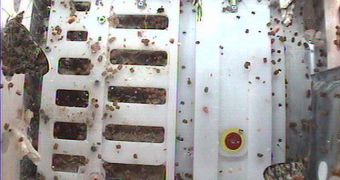When the space shuttle Atlantis took off to the International Space Station (ISS) in mid-November, it carried with it, among other experiments, a living one as well. Its payload bay also included the “CSI 03 – Butterflies in Space” experiment, which is built by experts at the University of Colorado in Boulder (UCB) Aerospace Engineering Department, and designed by the company BioServe Space Technologies. Just recently, as children around the United States were watching, the four larvae became adults, and began to fly through their enclosure awkwardly, Space Fellowship reports. All of them are in good health, experts report.
The suitcase-sized payload has been in use for delivering similar experiments to orbit for many years, and this is one of the main reasons why it was also selected to be employed for the butterfly project. The main goal of this initiative was to provide students with the ability to watch the butterflies undergoing their natural evolution cycle from larvae to adults, all while subjected to the unusual conditions of microgravity. “All four larvae formed chrysalises and two emerged as butterflies on November 30. Two more butterflies emerged overnight,” BST Payload Mission Manager Stefanie Countryman shares.
All of the students that take part in this program have set up similar habitats in their own classrooms, so as to be able to compare the behavior of their own butterflies to the one exhibited by the space insects. “The larvae didn’t seem to have problems navigating and feeding in the space environment. Now, the opportunities to investigate microgravity’s effect on adult butterfly behavior, wing development and flight are beginning,” Baylor College of Medicine (BCM) Center for Educational Outreach Senior Associate Director and Professor of Health Sciences Dr. Nancy Moreno adds.
“One of the most exciting things about this project is that we can use the International Space Station to bring spaceflight experiments into classrooms around the country. Our continuing goal is to inspire K-12 students around the country in science, technology, engineering and math,” the principal investigator on the project, BioServe Director Louis Stodieck, said before the shuttle took off, on November 16. “The photos and video are being archived, so classrooms can participate in the experiment at any time and compare their classroom larvae with photos of space larvae at the same developmental stage,” Moreno concludes.

 14 DAY TRIAL //
14 DAY TRIAL //